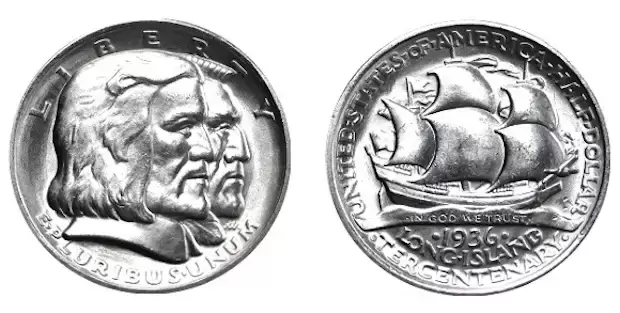 |
|
 |
|
 |
|
 |
|
 |
|
 |
|
 |
|
 |
|
 |
|
 |
|
 |
|
 |
|
 |
|
 |
|
 |
|
The Long Island Tercentenary Half Dollar was released in 1936 to commemorate Long Island's 300th anniversary.

A committee was formed to celebrate the 300th anniversary of European settlers coming to Long Island - specifically in Brooklyn. To commemorate the event, the committee successfully petitioned Congress to mint a coin.
History
The Long Island Tercentenary Half Dollar was released in 1936 to commemorate Long Island’s 300th anniversary. According to a story in the New York Times, "Those Dutch colonists sailed into Jamaica Bay in 1636, bought a 118-mile strip of land from 13 Algonquin tribes and called it Lange Eylandt." The coin was designed by Howard Weinman, the son of Adolph A. Weinman, who designed the Mercury dime and Walking Liberty half dollar.
A committee - called The Long Island Tercentenary Committee - wanted a coin to mark the 300th anniversary of the first European settlement in Brooklyn. On April 13, 1936, a bill was signed by President Franklin D. Roosevelt and 100,000 coins were struck.
The Design
On the face of the coin are the likenesses of a Dutch settler and a member of the Algonquin tribe of Native Americans. Weinman provided insight into the symbolism, expressing, "I shall try to infer by the harmonious balance of the heads the peaceful settlement of the island by the Dutch.” On the reverse side, a Dutch three-masted ship captures the imagination as it sails gracefully to the right, traversing tumultuous waves. Amidst this maritime panorama, the phrase "IN GOD WE TRUST" stands out prominently, accompanied by the nation's name and the coin's denomination. Completing the narrative is the inscription "LONG ISLAND TERCENTENARY.”
Sale
By the time of their release in August, the festivities marking the Long Island celebrations had concluded, organized by the Tercentenary Committee in May. Arlie Slabaugh, in his work on commemoratives, noted, "Despite this, the Long Island Tercentenary Committee managed to effectively distribute these coins through local banks." Once minted, the coins were transported to the National City Bank in Brooklyn, where they were made available to the public for $1 each at various locations.
The Brooklyn Eagle newspaper office alone offered 50,000 coins, with an additional 25,000 in Queens, 15,000 in Nassau County, and 10,000 in Suffolk County. They were also sold at department stores across Brooklyn.
Despite a delayed release and minimal advertising, the coins saw brisk sales, with 81,826 out of 100,000 coins sold. The remaining unsold coins were returned to the mint for melting.
Criticism
Art historian Cornelius Vermeule, in his book on American coins and medals, said, "The Dutch pioneer looks like a character out of Shakespeare (a peasant part), and the Indian could easily play professional football any Sunday afternoon across the United States. Otherwise, beyond those cliches brought about in an effort to modernize traditionally ideal subjects, the ship has a correct amount of simplicity, and the lettering seems to fade into the background in a satisfying fashion."
“Because of the lantern jaws and prominent noses of the obverse profiles, critics have likened them to two boxers about to square off,” said a New York Times article on the coin. “The ship on the reverse, it was noted, was shown sailing east, or away from the New World.”
Coin Collectors
Because of mistreatment in the mint, in distribution and in the way it was designed, the 90-percent-silver coin (it is 10 percent copper) has not fared well as far as quality of existing coins on the coin collector market.
''Long Islands don't generally come nice,'' said Marty Rubinstein, a Bay Shore coin dealer in the New York Times article.
Prices for these coins can go from $65 up to over $400 in mint condition, a rare find.
The coin is relatively unknown to the general public but collectors like them. One coin site said that, “Hoards filtered into the marketplace into the 1960s, ensuring this coin remains relatively common in the industry even now.”
Disclaimer:info@kdj.com
The information provided is not trading advice. kdj.com does not assume any responsibility for any investments made based on the information provided in this article. Cryptocurrencies are highly volatile and it is highly recommended that you invest with caution after thorough research!
If you believe that the content used on this website infringes your copyright, please contact us immediately (info@kdj.com) and we will delete it promptly.
-

-

-

-
![Bitcoin [BTC] has experienced sustained gains, rising from a local low of $83k to a high of $95k. Bitcoin [BTC] has experienced sustained gains, rising from a local low of $83k to a high of $95k.](/assets/pc/images/moren/280_160.png)
-

- Dynamic Fee Structure for the Ethereum Application Layer
- Apr 28, 2025 at 06:55 am
- Two Ethereum community members, Kevin Owocki and Devansh Mehta, proposed a dynamic fee structure for the Ethereum application layer to strike a balance between revenue generation for app builders and fairness in fee extraction.
-

-

-

-

- Michael Saylor's Strategy is "synthetically halving" Bitcoin (BTC)
- Apr 28, 2025 at 06:45 am
- Adam Livingston, a BTC analyst and author of "The Bitcoin Age and The Great Harvest," said that Strategy's acquisition of 379,800 BTC in the last six months means the firm is purchasing roughly 2,087 BTC per day.























































![Bitcoin [BTC] has experienced sustained gains, rising from a local low of $83k to a high of $95k. Bitcoin [BTC] has experienced sustained gains, rising from a local low of $83k to a high of $95k.](/uploads/2025/04/28/cryptocurrencies-news/articles/bitcoin-btc-experienced-sustained-gains-rising-local-low-k-k/middle_800_480.webp)


